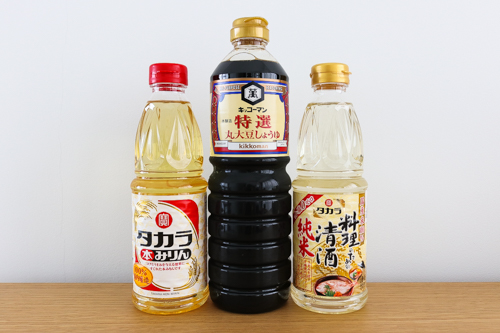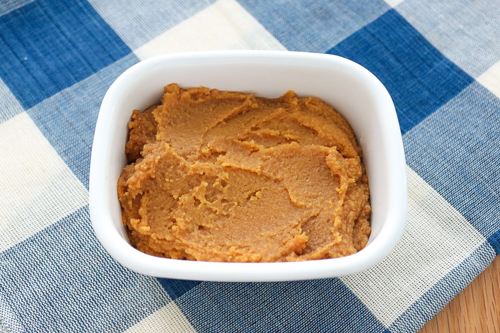Japanese recipes are simpler and easier than you’d think!
Japanese meals are generally viewed as being healthy, delicate and sophisticated. And we have a tendency to think that something healthy and tasty can’t also be easy. But that may be a myth when it comes to Japanese home-cooking as it’s actually easy and simple. In this post, I’ll be sharing some basic sauces, how to choose the right ones, and some tips on handling them properly. Let me repeat, Japanese recipes are very simple!
These are the 3+1 sauces to have. That’s it!
It is possible to cook hundreds of different Japanese dishes using only three basic sauces. These are #1 Soy Sauce, #2 Mirin (Sweet-rice Cooking Wine), and #3 Cooking Sake. Sukiyaki-sauce is made of using the three sauces plus sugar. Teriyaki-sauce is made of soy sauce, mirin and sugar. The good news is that you can find them in many big cities across the world, normally at a reasonable price. I’m based in Singapore (as of 2019) and I usually buy the three major brands below. (From left, cooking wine, soy sauce, and cooking sake.)

Additionally, Miso, if you have it, adds more variety to tastes! But Miso is not mandatory for beginners in Japanese cooking. There are plenty of recipes that can be prepared using just the three basic sauces, leaving you to try recipes containing Miso later on.

By the way, all of these sauces are predominantly made from rice and soybeans, which are essential staples in Japanese cuisine. These natural fermentation process enables these sauces to build up to not only umami, but more importantly, health benefits.
Tips for choosing the right one and handling it well
Now, you may be curious as to what these sauces are, how to choose and buy the right one, and if there are any tips for handling them properly. These ingredients are produced via natural fermentation process, which means it’s better to handle them a little carefully. But don’t worry, I won’t complicate it.
#1 Soy Sauce (Shoyu; 醤油)
What is it? What should I use it for?: Soy sauce is a liquid condiment with a salty flavor. It’s made from soybeans, wheat, salt, and fermenting agents such as yeast (Koji). The taste has a blend of salty, umami, and slight sweetness and bitterness. It’s used primarily for adding taste but is also good for adding aroma or color, or for its punch as a seasoning. When preparing preserved foods, it helps to dehydrate.
How to choose: See the list of ingredients and choose one that contains only the essential ingredients, i.e. soybeans, wheat, salt and a fermenting agent (printed as alcohol in many cases). I would not recommend one that contains added amino acids as additional umami. Umami is created by cooking several ingredients, meat/fish and vegetables, which means it’s not needed from soy sauce. Plus, the unnecessary umami from soy sauce can dilute or even kill the original flavor and taste of the ingredients.
Tips for cooking: Use it either at the beginning or end of cooking, depending on the recipe. When soy sauce is used to add aroma, add it at the end of cooking. The elegant part of the aroma tends to quickly disappear following prolonged heating.
#2 Sweet cooking rice-wine (Mirin; 味醂、みりん)
What is it? What should I use it for?: Mirin is a liquid condiment with mild sweetness and umami. The sweetness is subtle and milder than sugar. It’s made from sticky-rice and malted-rice, which are fermented with added alcohol (shochu). Because of this, it has a low alcohol content; however, this evaporates during the cooking process. It’s used primarily for adding umami with a subtle sweetness. It also helps to prevent fragile ingredients (such as fish) from falling apart when being cooked. Lastly it’s used to add a glaze as a finishing touch.
How to choose: Similar to soy sauce, choose one that contains only the essential ingredients, such as sticky-rice, malted-rice and alcohol (shochu). Some mirin contains added sugar for sweetness. Avoid one that has such excessive sweetness.
Tips for cooking: Ensure that the low alcohol content fully evaporates during cooking. (In other words, if you add mirin toward the end of cooking, be sure to leave enough time for the alcohol to evaporate.)
#3 Cooking Sake (Ryori-shu; 料理酒)
What is it? What should I use it for?: Cooking-sake is a type of sake produced primarily for the purpose of cooking. It’s made from rice, water and a fermenting agent (koji) with the addition of salt (2-3%) and/or vinegar. It does lots of jobs – it adds umami to dishes, softens ingredients, removes the odor of various ingredients, and reduces cooking time so that the original flavor of the ingredients is better retained.
How to choose: Again, choose one that contains only the essential ingredients, such as rice, water and koji. Watch out for any that contain sugar for added sweetness and umami. The extra and unnecessary sweetness dilute the original flavor/taste of the other ingredients.
Tips for cooking: In most cases, use it at the beginning of cooking in most cases, to ensure that all of the alcohol fully evaporates during cooking.
+1 Miso; 味噌
What is it? What should I use it for?: Miso is a traditional Japanese seasoning made from fermented soybeans with salt and a fermenting agent (koji). Some miso contains rice, barley, or other ingredients. It comes in the form of a thick paste, contains great umami, and is well known for its health benefits, being high in protein and rich in minerals and vitamins, etc. It’s typically salty, adds umami and flavor, and helps to remove odor from meat or fish.
How to choose: Once again, be sure to choose one that contains only the essential ingredients, such as soybeans, salt, koji and some other grains. There are two major types of miso – “red-miso” (akamiso) and “white-miso” (shiromiso). In short, red-miso is saltier and more umami, while white-miso has more sweetness. There is “mixed-miso” that combines the two types. For your first time buying and cooking with miso, I’d recommend going with white- or mixed-miso. (I usually use these too.)
Tips for cooking: The umami and flavor of miso disappear when subject to prolonged heating.
